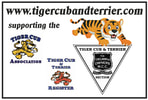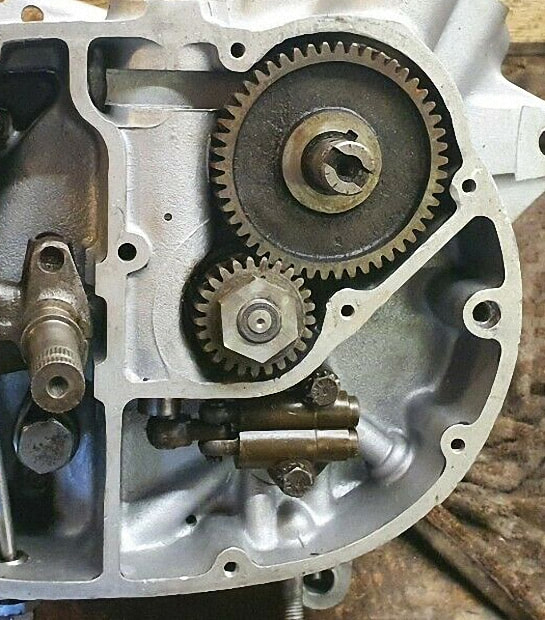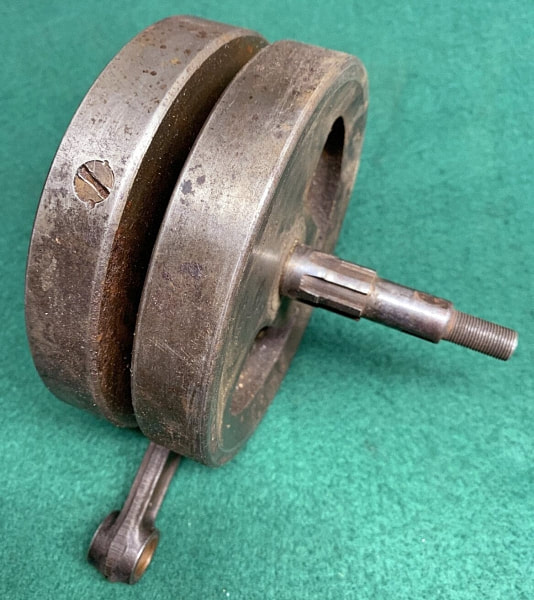Oil Pumps and Lubrication
|
The oil pump in all models of Cub and Terrier is of the twin-plunger type. Retained by two bolts, it's situated in the lower front section of the right-hand crankcase.
Operation is by an off-set pin machined into the lower end of a vertical shaft driven by a skew gear inboard of the timing pinion. The top end of the vertical shaft drives the distributor unit on those engines so equipped, and the skew gear and timing pinion locate in a taper machined into the end of the crankshaft. Engine lubrication on all models is of the dry sump principle, whereby oil is supplied to the pump from an external tank on the right of the machine. The smaller of the two plungers in the pump forces oil through to the crankshaft and crankpin/big-end. Lubricant escaping from the big-end is then splashed onto the cylinder walls and small-end before draining down into the sump, which holds a gauze filter. |
The larger plunger returns oil to the external tank where, before entering the tank, a junction in the return feed allows a certain amount of oil to be fed to the rocker shafts. This then drains down the pushrod tube, lubricating the cam followers and camshaft before finding its way back to the sump.
Be aware - On engines using a timing-side main bearing bush, good oil supply to the big end is totally reliant on a close tolerance fit of the bush on the crank journal.
Recommended clearance being just 0.001 to 0.0015 thousands of an inch.
During the course of Terrier and Cub production, a total of five different oil pumps were fitted. Each one an improvement over the last.
Be aware - On engines using a timing-side main bearing bush, good oil supply to the big end is totally reliant on a close tolerance fit of the bush on the crank journal.
Recommended clearance being just 0.001 to 0.0015 thousands of an inch.
During the course of Terrier and Cub production, a total of five different oil pumps were fitted. Each one an improvement over the last.
Changes by year
1954
From engine number 3905, the oil feed plunger on all models increased in size from 3/16" to 1/4"
From engine number 4859 the flywheel oilways were revised to provide a *sludge trap which could be cleaned by removing a bolt in the flywheel edge.
From engine number 10197 and to prevent oil draining from the oil tank through the pump and into the crankcases (wet sumping) whenever the machine was left unused for extended periods of time, spring loaded steel balls were fitted between the oil pump and crankcase to act as non-return valves.
1955
Oil tank capacity on all models increased from 2.25 to 2.75 pints.
1960
From engine number 69157 a new larger oil pump was fitted. Plunger sizes increased to 5/16" on the feed side and 3/8" on the scavenge to give around 60% more throughput of oil. An additional design feature on the new pump eliminated irregular wear on the ball valve seats.
1961
Up to this point all the oil pump bodies had been made of brass, but from engine number 81890 a new cast iron bodied pump appeared. With the exception of stronger springs it had exactly the same dimensions as the one it was replacing. The advantage of the new pump being that when hot, it gave a better flow rate than the brass item.
1964
From engine number 99720, the sludge trap capacity was increased along with a larger diameter screwed access plug.
1954
From engine number 3905, the oil feed plunger on all models increased in size from 3/16" to 1/4"
From engine number 4859 the flywheel oilways were revised to provide a *sludge trap which could be cleaned by removing a bolt in the flywheel edge.
From engine number 10197 and to prevent oil draining from the oil tank through the pump and into the crankcases (wet sumping) whenever the machine was left unused for extended periods of time, spring loaded steel balls were fitted between the oil pump and crankcase to act as non-return valves.
1955
Oil tank capacity on all models increased from 2.25 to 2.75 pints.
1960
From engine number 69157 a new larger oil pump was fitted. Plunger sizes increased to 5/16" on the feed side and 3/8" on the scavenge to give around 60% more throughput of oil. An additional design feature on the new pump eliminated irregular wear on the ball valve seats.
1961
Up to this point all the oil pump bodies had been made of brass, but from engine number 81890 a new cast iron bodied pump appeared. With the exception of stronger springs it had exactly the same dimensions as the one it was replacing. The advantage of the new pump being that when hot, it gave a better flow rate than the brass item.
1964
From engine number 99720, the sludge trap capacity was increased along with a larger diameter screwed access plug.
|
1965
During this year the oil pump body once more reverted to being manufactured in brass. It can also be noted, the spring-loaded steel balls to combat 'wet sumping' had stopped being specified. Oil pump dimensions were the same as the previous cast iron one, the change being the plungers were now operated by a slider-block mechanism giving an increased throw resulting in a 50% increase in the delivery of oil to the engine and a corresponding increase in scavenging capacity. This new pump was not fitted to all engines. On the ones that were, there was a difference in machining to the crankcase in order to accommodate the longer throw of the slider block. The later slider block pump can be fitted to an earlier non-slider block crankcase, however modification to the earlier crankcase is required by removal of metal to adequately clear the sliding block of the later pump at its extreme of movement. Caution: if this is not done correctly there is a chance of the slider or bridge ends of the oil pump pistons touching the casing. This may not be apparent when the pump is operated slowly by hand but once the engine is running, could result in consequential shearing of the eccentric drive pin. The photo shows a crankcase modified using a mini-grinder but accurate milling would provide a neater job. |
* Sludge Trap
The sludge trap is in the timing side crankshaft half, sealed with a screw whose head should be peened in to keep it from loosening off. It acts as a centrifugal oil filter which prevents dirt, sludge, and unwanted debris from working its way to the big end bearing. It does its job well, the problem being it can only be cleaned out after a full engine strip, so here's a word of warning. If you have stripped your engine DO NOT omit to clean it - a clogged sludge trap WILL prevent oil reaching the big end bearing! |





